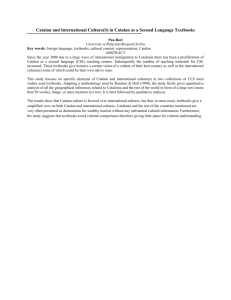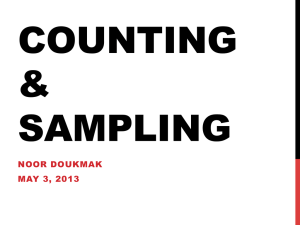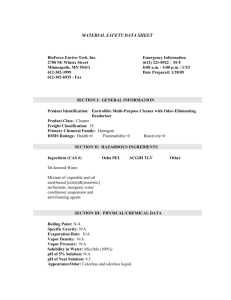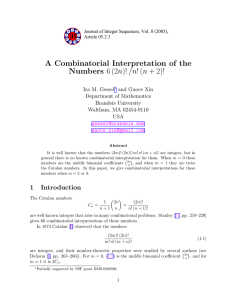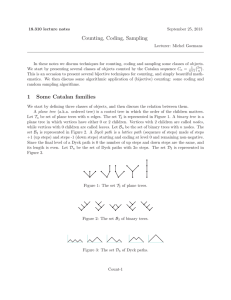Fall 2015, Math 431: Week 2 Problem Set Elementary Counting Methods
advertisement
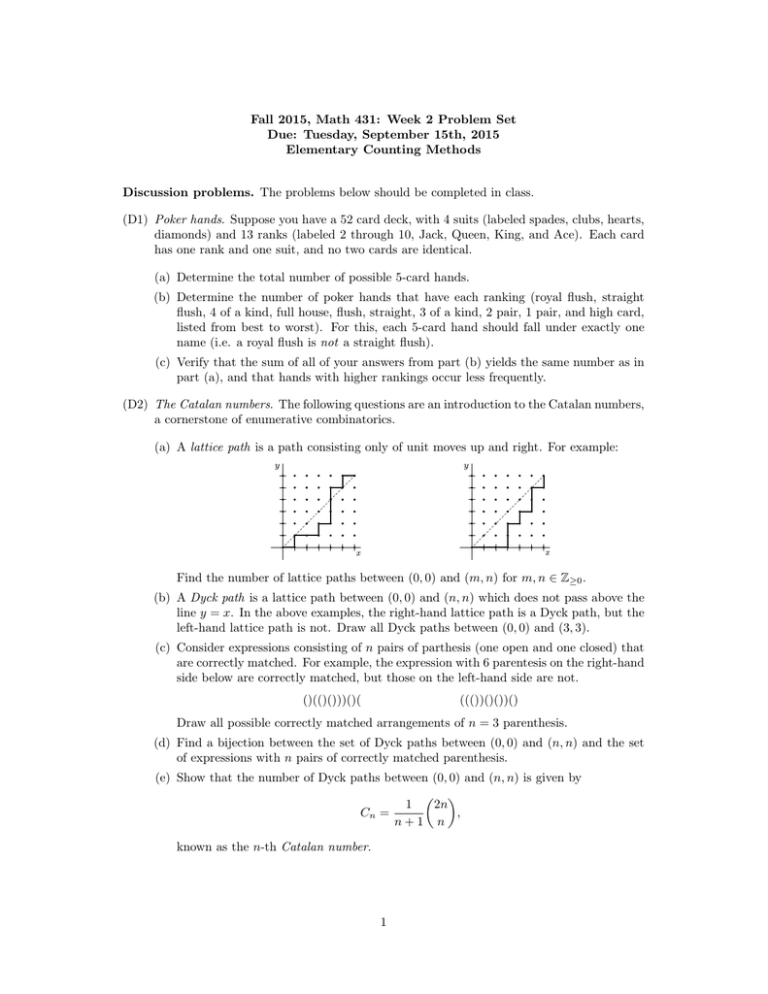
Fall 2015, Math 431: Week 2 Problem Set Due: Tuesday, September 15th, 2015 Elementary Counting Methods Discussion problems. The problems below should be completed in class. (D1) Poker hands. Suppose you have a 52 card deck, with 4 suits (labeled spades, clubs, hearts, diamonds) and 13 ranks (labeled 2 through 10, Jack, Queen, King, and Ace). Each card has one rank and one suit, and no two cards are identical. (a) Determine the total number of possible 5-card hands. (b) Determine the number of poker hands that have each ranking (royal flush, straight flush, 4 of a kind, full house, flush, straight, 3 of a kind, 2 pair, 1 pair, and high card, listed from best to worst). For this, each 5-card hand should fall under exactly one name (i.e. a royal flush is not a straight flush). (c) Verify that the sum of all of your answers from part (b) yields the same number as in part (a), and that hands with higher rankings occur less frequently. (D2) The Catalan numbers. The following questions are an introduction to the Catalan numbers, a cornerstone of enumerative combinatorics. (a) A lattice path is a path consisting only of unit moves up and right. For example: Find the number of lattice paths between (0, 0) and (m, n) for m, n ∈ Z≥0 . (b) A Dyck path is a lattice path between (0, 0) and (n, n) which does not pass above the line y = x. In the above examples, the right-hand lattice path is a Dyck path, but the left-hand lattice path is not. Draw all Dyck paths between (0, 0) and (3, 3). (c) Consider expressions consisting of n pairs of parthesis (one open and one closed) that are correctly matched. For example, the expression with 6 parentesis on the right-hand side below are correctly matched, but those on the left-hand side are not. ()(()()))()( ((())()())() Draw all possible correctly matched arrangements of n = 3 parenthesis. (d) Find a bijection between the set of Dyck paths between (0, 0) and (n, n) and the set of expressions with n pairs of correctly matched parenthesis. (e) Show that the number of Dyck paths between (0, 0) and (n, n) is given by 1 2n Cn = , n+1 n known as the n-th Catalan number. 1 (f) It turns out that the Catalan numbers satisfy C0 = 1 and the relation Cn+1 = n X Ci Cn−i . i=0 Use this to show that the Catalan numbers also count the number of ways of parenthesizing the product of n + 1 values. For instance, if n = 3, there are 5 ways: ((ab)c)d (ab)(cd) (a(bc))d a((bc)d) a(b(cd)) Required problems. As the name suggests, you must submit all required problem with this homework set in order to receive full credit. (R1) Given n, m ≥ 1, how many functions [n] → [m] are one-to-one? (R2) Fix positive prime integers p1 , . . . , pk and positive integers a1 , . . . , ak , and let n = pa1 1 · · · pakk . How many positive divisors does n have? (R3) Suppose a1 + · · · + ak ≤ n. Prove that a1 ! · · · ak ! < n!. (R4) Determine the number of ways to place n non-attacking rooks on an n × n chess board. (R5) Prove that exactly half of the subsets of [n] have an even number of elements. (R6) In how many ways can we select two subsets A, B ⊂ [n] such that A ∩ B = ∅? (R7) Determine the number of ways to cut an (n + 2)-gon into triangles using nonintersecting diagonals. Does your formula look familiar? Selection problems. You are required to submit all parts of one selection problem with this problem set. You may submit additional selection problems if you wish, but please indicate what you want graded. Although I am happy to provide written feedback on all submitted work, no extra credit will be awarded for completing additional selection problems. (S1) Let P denote a convex n-gon in which no 3 diagonals intersect in a single point. How many intersection points do the diagonals of P have? (S2) Suppose you have an n × n matrix whose entries lie in [n2 ], and the sum of every row and column is exactly r. Find all possible values of r. Challenge problems. Challenge problems are not required for submission, but bonus points will be awarded for submitting a partial attempt or a complete solution. (C1) How many non-attacking queens that can be placed on an n × n chess board? (C2) How many n × n square matrices are there whose entries are 0 or 1 and in which every row and column has an even sum? 2




